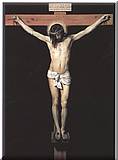Is nudity dirty?

Source: Velazquez, Crucifixion, c. 1631-2.

click here to see the edited image (as above) alongside the original, together with a similar treatment of a crucifixion by Rogier van der Weyden.
photography, writing, fine art... stuff ... other stuff ...

Source: Velazquez, Crucifixion, c. 1631-2.

click here to see the edited image (as above) alongside the original, together with a similar treatment of a crucifixion by Rogier van der Weyden.
The image on the left shows a naked man being tortured to death.
The form of execution portrayed was designed to prolong the process of dying,
and the ordeal could last several days. During the prisoner's preparation
for execution, and during the execution itself - a public spectacle - sexual
humiliation played an important part.
This scene, and related scenes such as the flagellation, have been exploited
for their homoerotic and pornographic potential for centuries. They have directly informed
the practice of modern artists working with gay issues and with issues of gender and eros,
such as Robert Mapplethorpe, and they have played a major role in shaping the contemporary
iconography of both the bdsm lifestyle and of bdsm- or fetish-oriented pornography / erotica.
For most of the last two thousand years, in most world cultures where capital punishment
has been a state policy, executions have been public, and have been attended by scenes
which make the connection with entertainment and sexual arousal unavoidable.
It is in this nexus of issues that I believe the question of nakedness ...
a 'published' nakedness, that is, as opposed to the private nakedness of domestic life ...
should first be located. Or at least this cluster of issues - we might call it the 'agonistic'
cluster of issues - shoule be given equal weight to those issues which have traditionally dominated
critical discourse concerning the nude. These traditional issues I would regard as issues of gender,
the politics and economics of sexuality, issues of 'innocence', 'nature' or 'naturalness',
and issues relating to the essentially privatised familial or domestic world
in which people bathe, sleep, peform household tasks and take their leisure.
Of course, to make work which involves the naked figure - and maybe most obviously when
the medium is photography - raises issues of sexuality. I would argue, however, that what we
might call the 'pleasureable' nude (in contrast to the agonistic ... and not ignoring the question
of exactly whose pleasure is at issue) is important as much for it's healing or even salvific
potential as for its capacity to cause sexual arousal. To put it less academically, I really
love that track from Leonard Cohen's album The Future ... the track is 'Light As The Breeze' ...
I knelt there at the delta,
at the Alpha and Omega.
I knelt there like one who believes.
And just for a second,
like a blessing come from heaven,
I was healed and my heart was at ease.
OK, but ... weren't we talking about dirtiness? ...